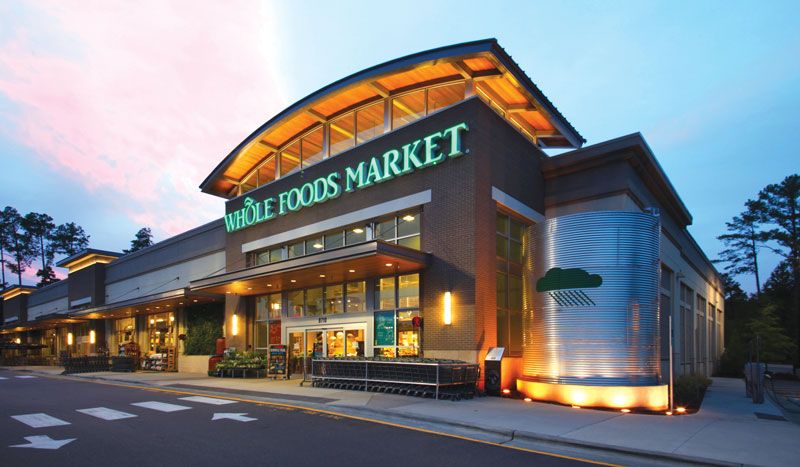How Stormwater Retention Paid Dividends for Three Sites
Published on by Water Network Research, Official research team of The Water Network in Business
Urban Land Institute hosted a webinar looking at how three different land uses were able to economically include stormwater diversion infrastructure in ways that added value.
From a park in Washington, D.C., to a former department store warehouse in Portland, Oregon, to a Whole Foods site in suburban Raleigh, North Carolina, these diverse projects are linked by a common ingenuity in handling stormwater challenges.

A cistern to the right of the grocery store’s entrance can hold 11,700 gallons (44,000 liters) of water for use inside the store-and alerts customers to the project’s commitment to sustainability. (Regency Centers)
These three examples were among many showcased in the Institute’s recent report, Harvesting the Value of Water: Stormwater, Green Infrastructure, and Real Estate, which highlighted the numerous ways in which water is not merely a threat requiring defensive measures, but “one that can be harnessed to make cities more sustainable and livable.”
These examples ranged from a suburb near Dallas to a flood-prone site in New Orleans to a pier development in Boston—locations prone both to excess water and to too little water—and featured an assortment of tools that can be combined given the circumstances. It is both an address of problems for cities and individual properties and sometimes even a means to make a profit.
The projects featured in ULI’s webinar each involved differing approaches to water, designed to turn an unwelcome guest into a helpful one.
Brad Fennell, senior vice president at W.C. Smith, spoke about the public/private partnership of Canal Park in Southeast Washington, D.C., an infill park built in 2012 as an anchor both for the company’s construction nearby and for the neighborhood in general.
Property developers and owners also indicated that design and operation of stormwater projects requires a learning curve, particularly in terms of landscape maintenance for green infrastructure installations such as bioswales and rain gardens. The three-block park replaced a former bus parking lot and public housing, and its foliage and leisure space are immediately apparent. The park is a space for area residents and employees to leave their cares behind, but the park is a warren of underground activity. As Fennell commented, “While lush landscaped areas provide a tranquil area to picnic and engage in a civic way below the surface, the park’s hard at work capturing and cleaning stormwater. Most visitors to the park are unaware of the extensive stormwater recycling that’s happening under their feet.”
A complex system rests beneath the surface: one 40,000-gallon (151,000 liter) holding tank that pumps water to bioplanters that irrigate the landscape. The water is then routed to a second cistern of the same size, where it is then cleansed through microfilters before use in the park’s fountains and restrooms, and seasonally, in the park’s 10,000-square-foot (929 sq m) ice rink. This water is tested weekly for quality. It is designed not merely with the idea of collecting water from the park itself, but also from nearby blocks that might not accommodate stormwater as effectively. It remains necessary to augment the site’s uses with potable water for human consumption, but most needs can be filled by on-site collection.
The second project profiled was of a substantially different nature—not a permeable park, but a solid warehouse, a historically landmarked former department store warehouse in Portland. Working around the building’s historic character, plenty of improvements were still possible. Sidewalk bioswales were located on every side of the full-block building, and accentuated by an 11,700-square-foot (1,100 sq m) green roof also featuring a solar array. All water from the rooftop is collected and reused for toilet flushing.
In renovating the building, Gerding Edlen, the property management company, realized that an entirely new foundation would be necessary. Thus, they decided to seize this opportunity to place a cistern beneath that surface, according to Renee Loveland, director of sustainability, Gerding Edlen, “by going deeper into the basement and creating the floor above.” She estimated the necessary cost of reconstruction at about $60,000 in any case; for an additional “$80,000 in plumbing costs and pumps and motors and those sort of things,” they yielded a 169,000-gallon bunker for water in the building’s effective sub-basement.
The next project shifted yet again, from city to suburb, to a six-acre (2.4 ha) project, the Market at Collonade, which contains a Whole Foods and a smaller additional building. Chris Widmayer, vice president of Regency Centers, outlined the site’s constraints. “One is we did not have enough land to do traditional stormwater detention. The typical aboveground systems that we had looked at were too expensive.”
The site was additionally adjacent to a watershed and at active and frequent risk of stormwater runoff. They ended up with a site that is 80 percent impervious to water, and yet filled with other features to overcome this deficiency. As Widmayer commented, “A combination of cisterns to take the stormwater from the roof, subsurface infiltration systems, bioswales, and bioretention areas to clean the water, and landscape irrigation systems to use the water that has been reclaimed in a massive underground detention chamber.”
A cistern beneath the parking lot can contain 350,000 gallons (1.3 million liters) of water, used both for storage and to irrigate the landscaping. Another aboveground cistern next to Whole Foods collects all the water from the retailer’s roof, then uses it for assorted purposes within the store. It is a system that can absorb a remarkable amount of water. According to Widmayer, “with 36 inches of rainfall, only 0.6 inch [1.5 cm] float out of the system and into public storm systems.” In practical terms, “less stormwater runoff than the typical suburban house.”
Read more: Urban Land
Media
Taxonomy
- Rainwater Harvesting
- Technology
- Integrated Urban Water Management
- Stormwater Management
- Stormwater
- Urban Water
- Urban Resource Management
- Storm Water Management
- Urban Water Infrastructure